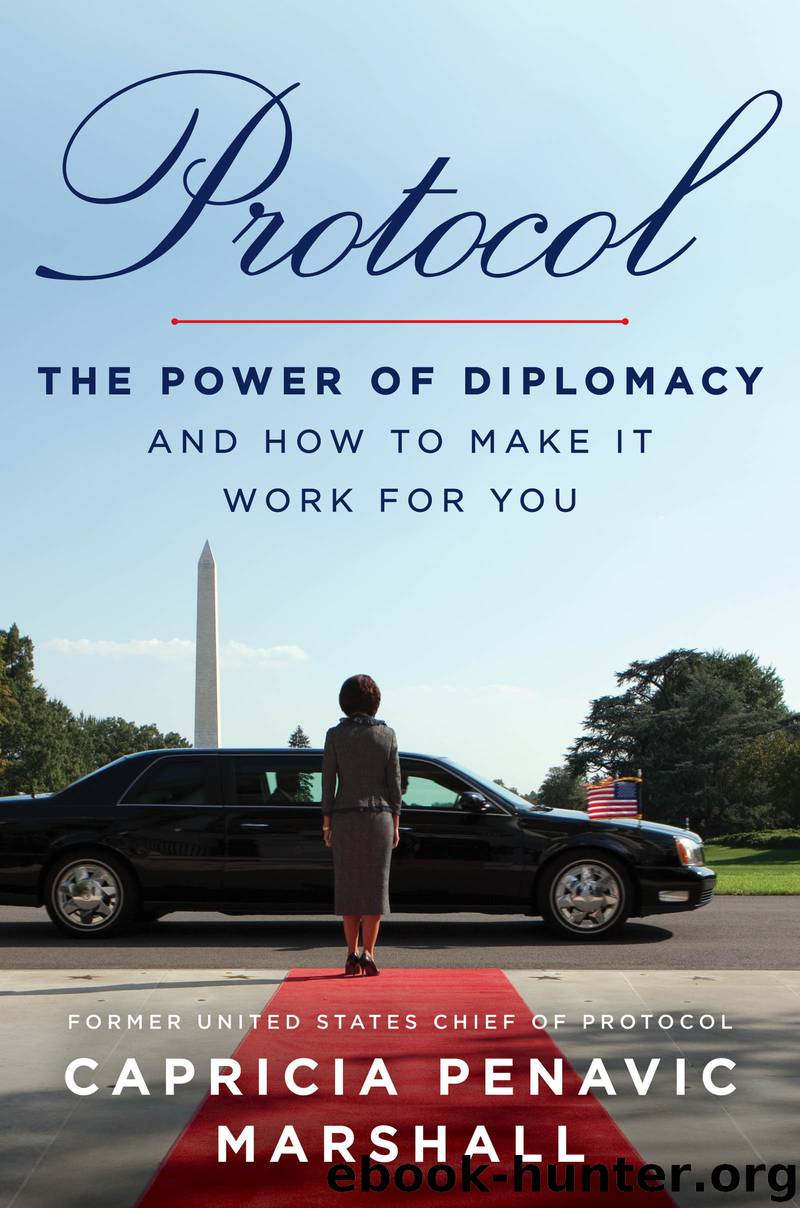Protocol by Capricia Penavic Marshall

Author:Capricia Penavic Marshall
Language: eng
Format: epub
Publisher: HarperCollins
Published: 2020-05-28T00:00:00+00:00
NOURISH YOUR NEGOTIATIONS
As crucial as food is to the brain and the body, the ancient tradition of breaking bread is also an important cultural tool and a potential source of power in interactions. “Food diplomacy was really the first kind of diplomacy,” says Secretary of State Hillary Clinton. “It was about reciprocity—if I share what I have with you now, you’ll return the favor to me if I get lost in the desert.”
I knew its influence from my White House days, when I witnessed food bringing people together during social events and resulting in serendipitous, game-changing conversations. At the White House state dinner in 1994 for Russia’s President Boris Yeltsin, the confluence of Steven Spielberg, David Geffen, and Jeffrey Katzenberg at a table launched a discussion that hatched one of the most successful collaborations of all time. Over rack of lamb in an apricot chutney and fine wine, the three began forming the concept for DreamWorks, the motion picture studio responsible for producing films such as Shrek and Kung Fu Panda.
But it wasn’t until a certain chicken luncheon that I understood that a carefully planned menu could play a pivotal role in work settings. Early in my term as chief of protocol, Secretary Clinton was hosting an important bilateral meeting at the State Department. We were in the James Monroe Reception Room, a Wedgwood-blue-and-white salon named for our fifth president. (The secretary loved the room’s soft colors and held many lunch and dinner meetings there.) On that day, I was doing what I often do at functions: standing discreetly in the corner, surveying to make sure all was going according to the careful plan. (I’ve always wished that the chief of protocol could be issued an invisibility cloak, as in Harry Potter.) I watched as the main course was placed in front of Secretary Clinton: a simple meal of baked chicken, steamed rice, and vegetables. I noticed her pause and take it in, and then she turned and looked directly at me. Apparently, I was not invisible, after all. From years of service, I knew immediately what her expression meant: We could do better. It wasn’t that the meal was poorly prepared, but we had missed an opportunity to showcase our country’s culinary traditions and introduce our guests to another aspect of who we, as Americans, are. A light went off in my head: Here is another opportunity for our team to engage in smart power. Food would become an important tool of our diplomacy, a creative and delicious way to share the best of our nation and to advance any engagement.
The next morning, I huddled with the team, in particular the wonderful State Department chefs Jason Larkin and Chris James, who until then hadn’t been asked to fully unleash their creativity, and told them we had a new mission: to make food a key ingredient of smart diplomacy. Natalie Jones, who was then assistant chief of ceremonials, the point person in the office on all social events at the State Department, used her genius to help me develop this new initiative.
Download
This site does not store any files on its server. We only index and link to content provided by other sites. Please contact the content providers to delete copyright contents if any and email us, we'll remove relevant links or contents immediately.
| Arms Control | Diplomacy |
| Security | Trades & Tariffs |
| Treaties | African |
| Asian | Australian & Oceanian |
| Canadian | Caribbean & Latin American |
| European | Middle Eastern |
| Russian & Former Soviet Union |
The Secret History by Donna Tartt(16611)
The Social Justice Warrior Handbook by Lisa De Pasquale(11486)
Thirteen Reasons Why by Jay Asher(7783)
This Is How You Lose Her by Junot Diaz(5754)
Weapons of Math Destruction by Cathy O'Neil(5032)
Zero to One by Peter Thiel(4818)
The Myth of the Strong Leader by Archie Brown(4786)
Promise Me, Dad by Joe Biden(4441)
Stone's Rules by Roger Stone(4413)
Beartown by Fredrik Backman(4406)
How Democracies Die by Steven Levitsky & Daniel Ziblatt(4393)
The Fire Next Time by James Baldwin(4338)
100 Deadly Skills by Clint Emerson(4072)
A Higher Loyalty: Truth, Lies, and Leadership by James Comey(4027)
Rise and Kill First by Ronen Bergman(4009)
The David Icke Guide to the Global Conspiracy (and how to end it) by David Icke(3876)
The Farm by Tom Rob Smith(3870)
Secrecy World by Jake Bernstein(3774)
The Doomsday Machine by Daniel Ellsberg(3726)
